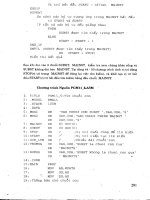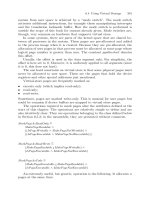netscreen concepts examples vpns phần 10 pot
Bạn đang xem bản rút gọn của tài liệu. Xem và tải ngay bản đầy đủ của tài liệu tại đây (471.78 KB, 27 trang )
1HW6FUHHQ&RQFHSWV([DPSOHV²9ROXPH931V
/73
This chapter provides an introduction to Layer 2 Tunneling Protocol (L2TP), its use alone and with IPSec support,
and then some configuration examples for L2TP and L2TP-over-IPSec:
• “Introduction to L2TP” on page 234
• “Packet Encapsulation and Decapsulation” on page 238
• “L2TP Parameters” on page 240
– “Example: Configuring an IP Pool and L2TP Default Settings” on page 241
• “L2TP and L2TP-Over-IPSec” on page 243
– “Example: Configuring L2TP” on page 244
– “Example: Configuring L2TP-over-IPSec” on page 250
&KDSWHU/73 ,QWURGXFWLRQWR/73
1HW6FUHHQ&RQFHSWV([DPSOHV²9ROXPH931V
,1752'8&7,2172/73
Layer 2 Tunneling Protocol (L2TP) provides a way for a dial-up user to make a virtual Point-to-Point Protocol (PPP)
connection to an L2TP network server (LNS), which can be a NetScreen device. L2TP sends PPP frames through a
tunnel between an L2TP access concentrator (LAC) and the LNS.
Originally, L2TP was designed so that a LAC residing at an ISP site tunneled to an LNS at either another ISP or
corporate site. The L2TP tunnel did not extend completely to the dial-up user’s computer, but only to the LAC at the
dial-up user’s local ISP. (This is sometimes referred to as a compulsory L2TP configuration.)
With the capability of a NetScreen-Remote client on Windows 2000 or Windows NT, or a Windows 2000 client by
itself, to act as a LAC, the L2TP tunnel can extend directly to the dial-up user’s computer, thus providing end-to-end
tunneling. (This approach is sometimes referred to as a voluntary L2TP configuration.)
Dial-up
Connection
ISP
Internet
L2TP Access
Concentrator
(LAC)
Corporate
LAN
Dial-up
User
NetScreen Device
L2TP Network
Server
(LNS)
L2TP Tunnel
(forwarding PPP sessions
from LAC to LNS)
&KDSWHU/73 ,QWURGXFWLRQWR/73
1HW6FUHHQ&RQFHSWV([DPSOHV²9ROXPH931V
Because the PPP link extends from the dial-up user across the Internet to the NetScreen device (LNS), it is the
NetScreen device, not the ISP, that assigns the client its IP address, DNS and WINS servers addresses, and
authenticates the user, either from the local database or from an external auth server (RADIUS, SecurID, or LDAP).
The dial-up user receives two IP addresses—one for its physical connection to the ISP, and a logical one from the
LNS. When the dial-up user contacts his or her ISP, perhaps using PPP, the ISP makes IP and DNS assignments,
and authenticates the user. This allows users to connect to the Internet with a routable IP address, which becomes
the outer IP address of the L2TP tunnel.
Internet
NetScreen-Remote
or Windows 2000
(LAC)
ISP
NetScreen Device
(LNS)
Corporate
LAN
L2TP Tunnel
(forwarding PPP sessions
from LAC to LNS)
IP Address: 212.30.40.56
DNS: 209.6.15.3, 209.6.15.4
ISP
1
&KDSWHU/73 ,QWURGXFWLRQWR/73
1HW6FUHHQ&RQFHSWV([DPSOHV²9ROXPH931V
Then, when the L2TP tunnel forwards the encapsulated PPP frames to the NetScreen device, the NetScreen device
assigns the user an IP address, and DNS and WINS settings. The IP address can be a private, nonroutable
address, which becomes the inner IP address of the L2TP tunnel.
2
IP Address: 10.10.1.161
DNS: 189.16.2.4, 189.16.2.5
WINS: 10.20.1.48, 10.20.1.49
IP Address Pool
10.10.1.1 – 10.10.1.254
NetScreen Device
(LNS)
Internet
&KDSWHU/73 ,QWURGXFWLRQWR/73
1HW6FUHHQ&RQFHSWV([DPSOHV²9ROXPH931V
The current version of ScreenOS provides the following L2TP support:
• L2TP tunnels originating from a host running Windows 2000
1
• A combination of L2TP and IPSec in transport mode (L2TP-over-IPSec)
– For NetScreen-Remote: L2TP-over-IPSec with Main mode negotiations using certificates, and
Aggressive mode using either a preshared key or certificates
– For Windows 2000: L2TP-over-IPSec with Main mode negotiations using certificates
• User authentication using either the Password Authentication Protocol (PAP) and Challenge Handshake
Authentication Protocol (CHAP) from the local database or an external auth server (RADIUS, SecurID, or
LDAP)
• The assignment of dialup users’ IP address, Domain Name System (DNS) servers, and Windows Internet
Naming Service (WINS) servers from either the local database or a RADIUS server
• L2TP tunnels and L2TP-over-IPSec tunnels for the root system and virtual systems
1. By default, Windows 2000 performs L2TP-over-IPSec. To force it to use L2TP only, you must navigate to the ProhibitIPSec key in the registry and change
0 (L2TP-over-IPSec) to 1 (L2TP only). (Before performing this, NetScreen recommends that you backup your registry.) Click Start > Run: Type regedit.
Double-click HKEY_LOCAL_MACHINE > System > CurrentControlSet > Services > RasMan > Parameters. Double-click ProhibitIPSec: Type 1 in the
Value data field, select Hexadecimal as the base value, and then click OK. Reboot. (If you do not find such an entry in the registry, see Microsoft WIndows
documentation for information on how to create one.)
Note: The local database and RADIUS servers support both PAP and CHAP. SecurID and LDAP servers
support PAP only.
Note: To use L2TP, the NetScreen device must be operating at Layer 3, with security zone interfaces in
NAT or Route mode. When the NetScreen device is operating at Layer 2, with security zone interfaces in
Transparent mode, no L2TP-related material appears in the WebUI, and L2TP-related CLI commands elicit
error messages.
&KDSWHU/73 3DFNHW(QFDSVXODWLRQDQG'HFDSVXODWLRQ
1HW6FUHHQ&RQFHSWV([DPSOHV²9ROXPH931V
3$&.(7(1&$368/$7,21$1''(&$368/$7,21
L2TP employs encapsulation of packets as the means for transporting PPP frames from the LAC to the LNS. Before
looking at specific examples for setting up L2TP and L2TP-over-IPSec, an overview of the encapsulation and
decapsulation involved in the L2TP process is presented.
(QFDSVXODWLRQ
When a dialup user on an IP network sends data over an L2TP tunnel, the LAC encapsulates the IP packet within a
series of layer 2 frames, layer 3 packets, and layer 4 segments. Assuming that the dialup user connects to the local
ISP over a PPP link, the encapsulation proceeds as follows:
1. The data is placed in an IP payload.
2. The IP packet is encapsulated in a PPP frame.
3. The PPP frame is encapsulated in an L2TP frame.
4. The L2TP frame is encapsulated in a UDP segment.
5. The UDP segment is encapsulated in an IP packet.
6. The IP packet is encapsulated in a PPP frame to make the physical connection between the dialup user and
the ISP.
&KDSWHU/73 3DFNHW(QFDSVXODWLRQDQG'HFDSVXODWLRQ
1HW6FUHHQ&RQFHSWV([DPSOHV²9ROXPH931V
'HFDSVXODWLRQ
When the LAC initiates the PPP link to the ISP, the decapsulation and forwarding of the nested contents proceed as
follows:
1. The ISP completes the PPP link and assigns the user’s computer an IP address.
Inside the PPP payload is an IP packet.
2. The ISP removes the PPP header and forwards the IP packet to the LNS.
3. The LNS removes the IP header.
Inside the IP payload is a UDP segment specifying port 1701, the port number reserved for L2TP.
4. The LNS removes the UDP header.
Inside the UDP payload is an L2TP frame.
5. The LNS processes the L2TP frame, using the tunnel ID and call ID in the L2TP header to identify the
specific L2TP tunnel. The LNS then removes the L2TP header.
Inside the L2TP payload is a PPP frame.
6. The LNS processes the PPP frame, assigning the user’s computer a logical IP address.
Inside the PPP payload is an IP packet.
7. The LNS routes the IP packet to its ultimate destination, where the IP header is removed and the data in the
IP packet is extracted.
ISP
LNS
&KDSWHU/73 /733DUDPHWHUV
1HW6FUHHQ&RQFHSWV([DPSOHV²9ROXPH931V
/733$5$0(7(56
The LNS uses L2TP to provide the PPP settings for a dial-up user that typically come from an ISP. These settings
are as follows:
• IP address – The NetScreen device selects an address from a pool of IP addresses and assigns it to the
dial-up user’s computer. The selection process operates cyclically through the IP address pool; that is, in a
pool from 1.1.1.1 to 1.1.1.3, the addresses are selected in the following cycle: 1.1.1.1 – 1.1.1.2 – 1.1.1.3 –
1.1.1.1 – 1.1.1.2 …
• DNS primary and secondary server IP addresses – The NetScreen device provides these addresses for the
dial-up user’s computer to use.
• WINS primary and secondary server IP addresses – The NetScreen device also provides these addresses
for the dial-up user’s computer to use.
The LNS also authenticates the user through a user name and password. You can enter the user in the local
database or in an external auth server (RADIUS, SecurID, or LDAP).
In addition, you can specify one of the following schemes for the PPP authentication:
• Challenge Handshake Authentication Protocol (CHAP), in which the NetScreen device sends a challenge
(encryption key) to the dial-up user after he or she makes a PPP link request, and the user encrypts his or
her login name and password with the key. The local database and RADIUS servers support CHAP.
• Password Authentication Protocol (PAP), which sends the dial-up user’s password in the clear along with
the PPP link request. The local database and RADIUS, SecurID, and LDAP servers support PAP.
• “ANY”, meaning that the NetScreen device negotiates CHAP, and then if that fails, PAP.
You can apply to dial-up users and dialup user groups the default L2TP parameters that you configure on the L2TP
Default Configuration page (VPNs > L2TP > Default Settings) or with the set l2tp default command. You can also
apply L2TP parameters that you configure specifically for L2TP users on the User Configuration page (Users >
Users > Local > New) or with the set user name_str remote-settings command. The user-specific L2TP settings
supersede the default L2TP settings.
Note: The RADIUS or SecurID server that you use for authenticating L2TP users can be the same server you use
for network users, or it can be a different server.
&KDSWHU/73 /733DUDPHWHUV
1HW6FUHHQ&RQFHSWV([DPSOHV²9ROXPH931V
([DPSOH&RQILJXULQJDQ,33RRODQG/73'HIDXOW6HWWLQJV
In this example, you define an IP address pool with addresses ranging from 10.1.3.40 to 10.1.3.100. You specify
DNS server IP addresses 210.11.6.2 (primary) and 210.11.6.3 (secondary). The NetScreen device performs PPP
authentication using CHAP.
:HE8,
1. Objects > IP Pools > New: Enter the following, and then click OK:
IP Pool Name: Sutro
Start IP: 10.1.3.40
End IP: 10.1.3.100
Note: You specify the auth server on a per-L2TP tunnel basis.
RADIUS
10.1.2.245
DNS 1
210.11.6.2
DNS 2
210.11.6.3
L2TP IP Pool
10.1.3.40 – 10.1.3.100
Internet
Trust
Zone
Note: The L2TP pool addresses
must be in a different subnet from
those in the Trust zone.
ethernet1,
10.1.2.1/24
Untrust
Zone
ethernet3,
210.1.2.1/24
&KDSWHU/73 /733DUDPHWHUV
1HW6FUHHQ&RQFHSWV([DPSOHV²9ROXPH931V
2. VPNs > L2TP > Default Settings: Enter the following, and then click Apply:
IP Pool Name: Sutro
PPP Authentication: CHAP
DNS Primary Server IP: 210.11.6.2
DNS Secondary Server IP: 210.11.40.3
WINS Primary Server IP: 0.0.0.0
WINS Secondary Server IP: 0.0.0.0
&/,
1. set ippool sutro 10.1.3.40 10.1.3.100
2. set l2tp default ippool sutro
3. set l2tp default ppp-auth chap
4. set l2tp default dns1 210.11.6.2
5. set l2tp default dns2 210.11.40.3
6. save
&KDSWHU/73 /73DQG/732YHU,36HF
1HW6FUHHQ&RQFHSWV([DPSOHV²9ROXPH931V
/73$1'/7329(5,36(&
Although the dial-up user can be authenticated using CHAP or PAP, an L2TP tunnel is not encrypted, and therefore
is not a true VPN tunnel. The purpose of L2TP is simply to permit the administrator of the local NetScreen device to
assign IP addresses to remote dial-up users. These addresses can then be referenced in policies.
To encrypt an L2TP tunnel, you need to apply an encryption scheme to the L2TP tunnel. Because L2TP assumes
that the network between the LAC and the LNS is IP, you can employ IPSec to provide encryption. This combination
is called L2TP-over-IPSec. L2TP-over-IPSec requires setting up both an L2TP tunnel and an IPSec tunnel with the
same endpoints, and then linking them together in a policy. L2TP-over-IPSec requires that the IPSec tunnel be in
transport mode so that the tunnel endpoint addresses remain in the clear. (For information about transport mode
and tunnel mode, see “Modes” on page 4.)
You can create an L2TP tunnel between a NetScreen device and a host running Windows 2000 if you change the
Windows 2000 registry settings. (For instructions on how to change the registry, see the footnote on page 237.)
You can create an L2TP-over-IPSec tunnel between a NetScreen device and either of the following VPN clients:
• A host running NetScreen-Remote on a Windows 2000 or Windows NT operating system
• A host running Windows 2000 (without NetScreen-Remote)
&KDSWHU/73 /73DQG/732YHU,36HF
1HW6FUHHQ&RQFHSWV([DPSOHV²9ROXPH931V
([DPSOH&RQILJXULQJ/73
In this example, you create a dialup user group called “fs” (for “field-sales”) and configure an L2TP tunnel called
“sales_corp,” using ethernet3 (Untrust zone) as the outgoing interface for the L2TP tunnel. The NetScreen device
applies the following default L2TP tunnel settings to the dialup user group:
• The L2TP users are authenticated via the local database.
• PPP authentication uses CHAP.
• The range of addresses in the IP pool (named “global”) is from 10.10.2.100 to 10.10.2.180
2
.
• The DNS servers are 210.11.6.2 (primary) and 210.11.40.3 (secondary)
The remote L2TP clients are on Windows 2000 operating systems. For information on how to configure L2TP on the
remote clients, refer to Windows 2000 documentation. Only the configuration for the NetScreen device end of the
L2TP tunnel is provided below.
2. The addresses in the L2TP IP pool must be in a different subnet than the addresses in the corporate network.
Note: An L2TP-only configuration is not secure. It is recommended only for debugging purposes.
Auth/L2TP Dialup
Users Group: fs
Adam
Betty
Carol
DNS 1: 210.11.6.2
DNS 2: 210.11.40.3
Corporate
Network
IP Pool: global
10.10.2.100 –
10.10.2.180
Internet
L2TP Tunnel:
sales_corp
Outgoing Interface
Untrust Zone
eth3, 123.2.2.1/24
Untrust
Zone
eth1, 10.20.1.1/24
Trust Zone
&KDSWHU/73 /73DQG/732YHU,36HF
1HW6FUHHQ&RQFHSWV([DPSOHV²9ROXPH931V
:HE8,
/738VHUV
1. Objects > Users > Local > New: Enter the following, and then click OK:
User Name: Adam
Status: Enable
L2TP User: (select)
User Password: AJbioJ15
Confirm Password: AJbioJ15
2. Objects > Users > Local > New: Enter the following, and then click OK:
User Name: Betty
Status: Enable
L2TP User: (select)
User Password: BviPsoJ1
Confirm Password: BviPsoJ1
3. Objects > Users > Local > New: Enter the following, and then click OK:
User Name: Carol
Status: Enable
L2TP User: (select)
User Password: Cs10kdD3
Confirm Password: Cs10kdD3
&KDSWHU/73 /73DQG/732YHU,36HF
1HW6FUHHQ&RQFHSWV([DPSOHV²9ROXPH931V
/738VHU*URXS
4. Objects > User Groups > Local > New: Type fs in the Group Name field, do the following, and then click
OK:
Select Adam and use the << button to move him from the Available
Members column to the Group Members column.
Select Betty and use the << button to move her from the Available Members
column to the Group Members column.
Select Carol and use the << button to move her from the Available Members
column to the Group Members column.
'HIDXOW/736HWWLQJV
5. Objects > IP Pools > New: Enter the following, and then click OK:
IP Pool Name: global
Start IP: 10.10.2.100
End IP: 10.10.2.180
6. VPNs > L2TP > Default Settings: Enter the following, and then click OK:
IP Pool Name: global
PPP Authentication: CHAP
DNS Primary Server IP: 210.11.6.2
DNS Secondary Server IP: 210.11.40.3
WINS Primary Server IP: 0.0.0.0
WINS Secondary Server IP: 0.0.0.0
&KDSWHU/73 /73DQG/732YHU,36HF
1HW6FUHHQ&RQFHSWV([DPSOHV²9ROXPH931V
/737XQQHO
7. VPNs > L2TP > Tunnel > New: Enter the following, and then click OK:
Name: sales_corp
Dialup Group: Local Dialup Group - fs
Authentication Server: Local
Outgoing Interface: ethernet3
Peer IP: 0.0.0.0
3
Host Name (optional): Enter the name of the computer acting as the LAC
4
.
Secret (optional): Enter a secret shared between the LAC and the LNS.
Keep Alive: 60
5
3. Because the peer’s ISP dynamically assigns it an IP address, enter 0.0.0.0 here.
4. To find the name of a computer running Windows 2000, do the following: Click Start > Settings > Control Panel > System. The System Properties dialog
box appears. Click the Network Identification tab, and see entry following Full computer name.
Note: To add a secret to the LAC for authenticating the L2TP tunnel, you must modify the Windows 2000
registry as follows:
(1) Click Start > Run, and then type regedit. The Registry Editor opens.
(2) Click HKEY_LOCAL_MACHINE.
(3) Right-click SYSTEM, and then select Find from the pop-up menu that appears.
(4) Type ms_l2tpminiport, and then click Find Next.
(5) In the Edit menu, highlight New, and then select String Value.
(6) Type Password.
(7) Double-click Password. The Edit String dialog box appears.
(8) Type the password in the Value data field. This must be the same as the word in the L2TP Tunnel
Configuration Secret field on the NetScreen device.
(9) Reboot the computer running Windows 2000.
When using L2TP-over-IPSec, which is the Windows 2000 default, tunnel authentication is unnecessary; all
L2TP messages are encrypted and authenticated inside IPSec.
5. The Keep Alive value is the number of seconds of inactivity before the NetScreen device sends an L2TP hello signal to the LAC.
&KDSWHU/73 /73DQG/732YHU,36HF
1HW6FUHHQ&RQFHSWV([DPSOHV²9ROXPH931V
3ROLF\
8. Policies > (From: Untrust, To: Trust) New: Enter the following, and then click OK:
Source Address:
Address Book: Dial-Up VPN
Destination Address:
Address Book: Any
NAT: Off
Service: ANY
Action: Tunnel
Tunnel L2TP: sales_corp
Position at Top: (select)
&/,
'LDOXS8VHUV
1. set user adam type l2tp
2. set user adam password AJbioJ15
3. unset user adam type auth
6
4. set user betty type l2tp
5. set user betty password BviPsoJ1
6. unset user betty type auth
7. set user carol type l2tp
8. set user carol password Cs10kdD3
9. unset user carol type auth
6. Defining a password for a user automatically classifies the user as an auth user. Therefore, to define the user type strictly as L2TP, you must unset the auth
user type.
&KDSWHU/73 /73DQG/732YHU,36HF
1HW6FUHHQ&RQFHSWV([DPSOHV²9ROXPH931V
/738VHU*URXS
10. set user-group fs location local
11. set user-group fs user adam
12. set user-group fs user betty
13. set user-group fs user carol
'HIDXOW/736HWWLQJV
14. set ippool global 10.10.2.100 10.10.2.180
15. set l2tp default ippool global
16. set l2tp default auth server Local
17. set l2tp default ppp-auth chap
18. set l2tp default dns1 210.11.6.2
19. set l2tp default dns2 210.11.40.3
/737XQQHO
20. set l2tp sales_corp outgoing-interface ethernet3
21. set l2tp sales_corp auth server Local user-group fs
3ROLF\
22. set policy top from untrust to trust “Dial-Up VPN” any any tunnel l2tp sales_corp
23. save
&KDSWHU/73 /73DQG/732YHU,36HF
1HW6FUHHQ&RQFHSWV([DPSOHV²9ROXPH931V
([DPSOH&RQILJXULQJ/73RYHU,36HF
This example uses the same L2TP tunnel created in the previous example (“Example: Configuring L2TP” on page
244). Additionally, you overlay an IPSec tunnel onto the L2TP tunnel to provide encryption. The IPSec tunnel
negotiates Phase 1 in Aggressive Mode using a previously loaded RSA certificate, 3DES encryption and SHA-1
authentication. The certificate authority (CA) is Verisign. (For information on obtaining and loading certificates, see
Chapter 2, “Public Key Cryptography” on page 23.)The Phase 2 negotiation uses the security level predefined as
“Compatible” for Phase 2 proposals. The IPSec tunnel is in transport mode.
The predefined Trust zone and the user-defined Dialup zone are in the trust-vr routing domain. The interfaces for the
Dialup and Trust zones are ethernet2 (210.2.1.1/24) and ethernet1 (10.20.1.1/24) respectively. The Trust zone is in
NAT mode.
The dialup users Adam, Betty, and Carol use NetScreen-Remote clients on a Windows 2000 operating system
7
. The
NetScreen-Remote configuration for dialup user Adam is also included below. (The NetScreen-Remote
configuration for the other two dialup users is the same as that for Adam.)
7. To configure an L2TP-over-IPSec tunnel for Windows 2000 (without the NetScreen-Remote), the Phase 1 negotiations must be in Main mode and the IKE
ID type must be ASN1-DN.
IKE-L2TP
Dialup User Group: fs
Adam
Betty
Carol
DNS 1: 210.11.6.2
DNS 2: 210.11.40.3
IP Pool: global
10.10.2.100 –
10.10.2.180
L2TP Tunnel: sales_corp
VPN Tunnel: from_sales
Outgoing Interface
ethernet2, 210.2.1.1/24
Trust Zone
Dialup
Zone
Corporate
Network
ethernet1,
10.20.1.1/24
Internet
NetScreen-Remote
Clients
&KDSWHU/73 /73DQG/732YHU,36HF
1HW6FUHHQ&RQFHSWV([DPSOHV²9ROXPH931V
:HE8,
8VHU'HILQHG=RQH
1. Network > Zones > New: Enter the following, and then click OK:
Zone Name: Dialup
Virtual Router Name: trust-vr
Zone Type: Layer 3 (select)
Share Zone: (clear)
Block Intra-Zone Traffic: (select)
,QWHUIDFHV
2. Network > Interfaces > Edit (for ethernet1): Enter the following, and then click OK:
Zone Name: Trust
IP Address/Netmask: 10.20.1.1/24
3. Network > Interfaces > Edit (for ethernet2): Enter the following, and then click OK:
Zone Name: Dialup
IP Address/Netmask: 210.2.1.1/24
Note: The Trust zone is preconfigured. You do not need to create it.
&KDSWHU/73 /73DQG/732YHU,36HF
1HW6FUHHQ&RQFHSWV([DPSOHV²9ROXPH931V
,.(/738VHUV
4. Objects > Users > Local > New: Enter the following, and then click OK:
User Name: Adam
Status: Enable
IKE User: (select)
Simple Identity: (select)
8
IKE Identity:
L2TP User: (select)
User Password: AJbioJ15
Confirm Password: AJbioJ15
5. Objects > Users > Local > New: Enter the following, and then click OK:
User Name: Betty
Status: Enable
IKE User: (select)
Simple Identity: (select)
IKE Identity:
L2TP User: (select)
User Password: BviPsoJ1
Confirm Password: BviPsoJ1
8. The IKE ID that you enter must be the same as the one that the NetScreen-Remote client sends, which is the e-mail address that appears in the certificate
that the client uses for authentication.
&KDSWHU/73 /73DQG/732YHU,36HF
1HW6FUHHQ&RQFHSWV([DPSOHV²9ROXPH931V
6. Objects > Users > Local > New: Enter the following, and then click OK:
User Name: Carol
Status: Enable
IKE User: (select)
Simple Identity: (select)
IKE Identity:
L2TP User: (select)
User Password: Cs10kdD3
Confirm Password: Cs10kdD3
,.(/738VHU*URXS
7. Objects > User Groups > Local > New: Type fs in the Group Name field, do the following, and then click
OK:
Select Adam and use the << button to move him from the Available
Members column to the Group Members column.
Select Betty and use the << button to move her from the Available Members
column to the Group Members column.
Select Carol and use the << button to move her from the Available Members
column to the Group Members column.
'HIDXOW/736HWWLQJV
8. Objects > IP Pools > New: Enter the following, and then click OK:
IP Pool Name: global
Start IP: 10.10.2.100
End IP: 10.10.2.180
&KDSWHU/73 /73DQG/732YHU,36HF
1HW6FUHHQ&RQFHSWV([DPSOHV²9ROXPH931V
9. VPNs > L2TP > Default Settings: Enter the following, and then click Apply:
IP Pool Name: global
PPP Authentication: CHAP
DNS Primary Server IP: 210.11.6.2
DNS Secondary Server IP: 210.11.40.3
WINS Primary Server IP: 0.0.0.0
WINS Secondary Server IP: 0.0.0.0
10. VPNs > L2TP > Tunnel > New: Enter the following, and then click OK:
Name: sales_corp
Dialup Group: (select), Local Dialup Group - fs
Authentication Server: Local
Outgoing Interface: ethernet2
Peer IP: 0.0.0.0
9
Host Name (optional): If you want to restrict the L2TP tunnel to a specific
host, enter the name of the computer acting as the LAC
10
.
Secret (optional): Enter a secret shared between the LAC and the LNS
11
Keep Alive: 60
12
9. Because the IP address of the peer is dynamic, enter 0.0.0.0 here.
10. To find the name of a computer running Windows 2000, do the following: Click Start > Settings > Control Panel > System. The System Properties dialog
box appears. Click the Network Identification tab, and see entry following Full computer name.
Note: The host name and secret settings can usually be ignored. Only
advanced users are recommended to use these settings.
11. To add a secret to the LAC for authenticating the L2TP tunnel, you must modify the Windows 2000 registry. See the note in the previous example.
12. The Keep Alive value is the number of seconds of inactivity before the NetScreen device sends an L2TP hello signal to the LAC.
&KDSWHU/73 /73DQG/732YHU,36HF
1HW6FUHHQ&RQFHSWV([DPSOHV²9ROXPH931V
9317XQQHO
11. VPNs > AutoKey Advanced > Gateway > New: Enter the following, and then click OK:
Gateway Name: field
Security Level: Custom
Remote Gateway Type:
Dialup User Group: (select), Group: fs
Outgoing Interface: ethernet2
> Advanced: Enter the following advanced settings, and then click Return to
return to the basic Gateway configuration page:
Security Level: User Defined: Custom
Phase 1 Proposal: rsa-g2-3des-sha
Mode (Initiator): Aggressive
13
Preferred Certificate (Optional):
Peer CA: Verisign
Peer Type: X509-SIG
12. VPNs > AutoKey IKE > New: Enter the following, and then click OK:
Name: from_sales
Security Level: Compatible
Remote Gateway: Predefined: field
> Advanced: Enter the following advanced settings, and then click Return to
return to the basic AutoKey IKE configuration page:
Security Level: Compatible
Transport Mode: (select)
13. Windows 2000 (without NetScreen-Remote) supports Main mode negotiations only.
&KDSWHU/73 /73DQG/732YHU,36HF
1HW6FUHHQ&RQFHSWV([DPSOHV²9ROXPH931V
3ROLF\
13. Policies > (From: Dialup, To: Trust) New: Enter the following, and then click OK:
Source Address:
Address Book: (select), Dial-Up VPN
Destination Address:
Address Book: (select), Any
Service: ANY
Action: Tunnel
Tunnel VPN: from_sales
Modify matching VPN policy: (clear)
L2TP: sales_corp
Position at Top: (select)
&KDSWHU/73 /73DQG/732YHU,36HF
1HW6FUHHQ&RQFHSWV([DPSOHV²9ROXPH931V
&/,
8VHU'HILQHG=RQH
1. set zone name dialup
2. set zone dialup vrouter trust-vr
3. set zone dialup block
,QWHUIDFHV
4. set interface ethernet1 zone trust
5. set interface ethernet1 ip 10.20.1.1/24
6. set interface ethernet2 zone dialup
7. set interface ethernet2 ip 210.2.1.1/24
/73,.(8VHUV
1. set user adam type ike l2tp
2. set user adam password AJbioJ15
3. unset user adam type auth
4. set user adam ike-id u-fqdn
5. set user betty type ike l2tp
6. set user betty password BviPsoJ1
7. unset user betty type auth
8. set user betty ike-id u-fqdn
9. set user carol type ike l2tp
10. set user carol password Cs10kdD3
11. unset user carol type auth
12. set user carol ike-id u-fqdn









